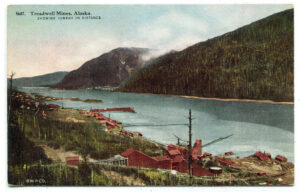- 1899

Treadwell Mines, showing Juneau in the distance. Winter & Pond Co. tinted postcard.
The Treadwell 300 stamp mill began operation in May and was the largest stamp mill in the world, crushing nearly 1,000 tons of ore a day. Alaska United Gold Mining Company’s 700 Ft. mine began operation of its 100-stamp mill. The Treadwell complex now was one of the world’s largest gold mines with 4 mines operating 5 mills totaling 880 stamps. The Alaska Treadwell and Mexican mines had paid dividends totaling $1,566,931 by this time. Enough ore was in sight to keep the mines going for 20 years.
In June Congress passed a liquor licensing act for Alaska, fees depending on population of the area. Juneau’s fee was $1,000; subsequently the number of saloons dropped from around 30 to 14. Juneau was the first city in Alaska to furnish an armory for her home troops and a regimental band was being organized for Company B. In November Juneau acquired an up-to-date hand fire engine which had 300 feet of hose and would throw a stream of water 100 feet.
Joe Juneau, a co-founder of Juneau, died of pneumonia March 1 in Dawson City, Yukon. He was running a restaurant at the time of his death. His body was later brought back to Juneau and interred in Evergreen Cemetary in 1903.
The first balloon ascension and parachute jump from about 1000 feet up, the first to be seen in Alaska, was made on the 4th of July by “Professor Leonard.”
Another decent also made news and the reputation of a Treadwell miner, Charles Johnson. On April 24 he was being hoisted to the surface in the main shaft of the Treadwell, when, apparently out of sheer absent mindedness, he stepped off the skip and plunged down the shaft. A party of the miners went down expecting to gather Johnson’s remains but instead, they found him standing in two feet of water at the bottom of the shaft. He was examined by the company physician, who found a bruise on his leg and another on one arm, and some signs of shock. Johnson said he remembered passing the 110-foot level in the shaft going down, but remembered nothing after that. The first newspaper report of Johnson’s fall gave the distance as 250 feet, but some of the miners got a steel tape and measured it exactly to be 256 feet. Now and then his name appeared in the newspapers, but it was never again just plain Charles Johnson. He was known thereafter as 256-foot Johnson.
